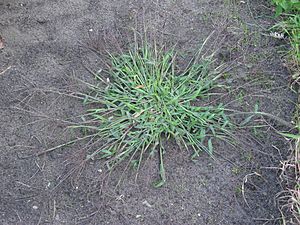Digitaria sanguinalis facts for kids
Quick facts for kids Digitaria sanguinalis |
|
|---|---|
 |
|
| Scientific classification | |
| Genus: |
Digitaria
|
| Species: |
sanguinalis
|
Digitaria sanguinalis is a type of grass known by many names, like hairy crabgrass or hairy finger-grass. It's a very common plant found almost everywhere in the world. While many people see it as a weed, it's also used to feed animals. Its seeds are even edible and have been used as a grain in some countries, especially Poland, where it's sometimes called "Polish millet."
Contents
What is Hairy Crabgrass?
Hairy crabgrass is an annual plant, meaning it grows from seed, flowers, produces seeds, and then dies all within one year. It has stems that can grow quite long. At the top of these stems, you'll find its inflorescence (which is like its flower cluster). This cluster has up to nine very long, thin branches that spread out like fingers. Each branch has tiny spikelets (small groups of flowers) arranged in pairs. These parts of the plant can sometimes look reddish or purplish.
How People Use Crabgrass
For a long time, people have found uses for hairy crabgrass.
Food for People
During the Middle Ages in Europe, especially in Eastern Europe, Slavic peoples grew Digitaria sanguinalis. They would cook its seeds in soups and porridges, much like we use other grains today.
When immigrants came to the United States, they brought this plant with them. They would gather its seeds by hand to use as food. It's a special plant because it produces a lot of grain. It can also grow well in hot and dry places, and it helps keep other unwanted plants away.
Food for Animals
This grass is also very good for animals to eat. It's especially nutritious before it produces all its seeds. Farmers often plant it in fields so animals can graze on it. They might also cut it and bundle it up as hay to feed animals later. Compared to many other grasses, hairy crabgrass has a good amount of protein, which is important for animal health. Sometimes, farmers will even prepare their fields to encourage crabgrass to grow because it's such a good food source for their livestock.
Controlling Crabgrass
Even though it has uses, many people today see hairy crabgrass as a nuisance, especially in lawns. It spreads easily because its seeds are so widespread. Crabgrass tends to grow well in places where the soil isn't very rich or when there's a drought. This is because these conditions can weaken other grasses, making it easier for crabgrass to take over a nice lawn.
It can be tricky to get rid of. If you pull it, it might grow back. Using strong chemicals can also harm the other grasses around it. Since it's an annual plant, you can use special chemicals called preemergent herbicides in the spring. These stop the seeds from sprouting. The easiest way to control it in your lawn is to pull out small patches by hand. Also, keeping your lawn well-watered and mowing it to a height of about two to three inches can help prevent crabgrass from taking over.
Images for kids
See also
 In Spanish: Guarda rocío para niños
In Spanish: Guarda rocío para niños




